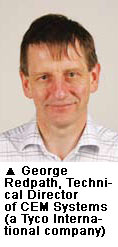While intrusion alarms are nothing new, they reign supreme in security. Today, innovation is boosting reliability, advancing scalability, reinforcing integration and catering to market needs.
While intrusion alarms are nothing new, they reign supreme in security. Today, innovation is boosting reliability, advancing scalability, reinforcing integration and catering to market needs.
According to an IMS Research report, the global market for intrusion alarm systems in 2007 was estimated at US$2.8 billion with sales increasing 9 percent over 2006. Heightened awareness of crime drove global demand with more individuals and organizations investing in perimeter security.
The EMEA was the biggest market ($1.07 billion) followed by the Americas ($1.04 billion). Factors affecting growth in the EMEA, said Paul Everett, Senior Research

Analyst for IMS Research, encompass the economy, national construction spending, home networks, VoIP, broadband and integration; these trends are also occurring in Asia and the Americas.
In the Americas, he said, reduction in false alarms and direct sales. "Overall, there are more than 100 suppliers of branded intrusion products in the EMEA with more than 50 in the Americas. The Americas market is dominated by top-tier players and is much more consolidated than in the EMEA," said Everett. Detectors and panels account for the vast majority.
For intrusion alarm sensors and detectors , most product development efforts focus on enhancing reliability, making designs more compact, installations more discreet and enabling IP (network) communication. "Nowadays, everything is IP-connected and wireless," said Eric Micko, Director of Suren Systems. "An emerging trend is customer demand for integrated solutions, covering onsite and immediate response personnel, electronic security and alarm systems," said Alfoson Garcia de Leaniz Caprile, International Sales, Bunker Seguridad.
PIR Cameras Deliver Advanced Protection
According to Jeanne-Marie Ferre, Marketing Manager at RSI Video Technologies, in most countries, the law demands that when alarms have been received by central monitoring stations, visual confirmation of the break-in is necessary before calling in law enforcement on pain of a $350 fine. The measure is meant to not only avoid useless callouts (more than 95 percent of alarms triggered are due to improper setting), but also increase police efficiency. Because of this, some manufacturers are using video verification technology on alarm sensors to reduce false alarms.
Greater consumer awareness of ease of installation, reliability and low maintenance costs of intruder alarms and sensors is expanding the market for Passive Infrared (PIR) camera and do-it-yourself (DIY) kits.
PIR cameras (P-cams) are easy to manage and very trendy. They combine digital

cameras, two-way premise and communications with central monitoring stations (CMS), and wireless sensors. The camera housed with the passive infrared sensor films events that set off alarms. It is activated only when the system is under surveillance and one of the sensors detects movement.
Via an encrypted radio link, footage is immediately relayed to the CMS. Thereby, CMS operators see video in real time, allowing them to determine whether the intrusion is real. Alarm and video transmission over Ethernet, global system for mobile communications (GSM) or general packet radio service (GPRS) cell notification is also available.
Novel video alarm systems are being widely deployed in Europe. The systems are geared toward small, rapidly installed applications. In comparison with traditional video surveillance, they are cost-efficient and easy-to-use. Well-known manufacturers include RSI Video Technologies, MTeye Security and Bosch Security Systems.
RSI Video Technologies p-cams feature built-in, two-lux video cameras with CMOS black-white sensors and communication of alarm and video wirelessly to the

controller and CMS; they see in the dark with two infrared LEDs for illumination. The p-cams also support up to four areas, 20 user pass codes and 24 wireless cameras and initiation points; they are entirely self-powered with no AC power connection. High-capacity lithium batteries provide wireless service up to or in excess of four years with minimal maintenance.
The latest DIY kits are standalone, portable security systems that come with their own customized military transport cases that can be wirelessly deployed in minutes. Video alerts can be delivered by multimedia text message formats or e-mails. "With our concept and GPRS module," said Ferre, users can secure any place: hotel rooms, offices, vacation homes, rental cars, documents while traveling, storage trailers, trucks, boats, marinas and even water towers.
To address privacy concerns, p-cams are activated only by armed sensors, meaning that nobody can spy on anyone else unless an alarm has been triggered either by an armed sensor or panic button.
Aside from RSI Video Technologies, MTeye Security's easy-to-install, battery-operated sensor has a color VGA, CMOS (640-pixel x 800-pixel) camera integrated with an MPEG-4 media processor and IR detector. When the sensor detects movement, it transmits live streaming video (up to 25 frames per second) to the CMS, while providing both 10-second pre and post video clips in file sizes of less than 100 kilobytes.
Unlike conventional wireless devices, PIR cameras are asleep 99 percent of the

time. They are synchronized to wake and look for instructions during the 1 percent that they are needed. This micromanaging of component duty cycles allows huge power savings without having an impact on effective supervision, performance or real (human) usage.
Distributed Intelligence
Chris Phinney, Product Marketing Manager, Intrusion, Bosch Security Systems Asia Pacific, said the alarm, photoelectric beam detector and PIR sensor sectors are an enormous but mature market. New developments in sensors and detectors are mostly concerned with better alarm assessment and IP communication.
Multilevel sensitivity adjustment to detect motion of real interest (pet immunity) and integrity of multiple detection principles (dual technology like PIR or infrared IR combined with microwave) are crucial technologies. Added interaction between the premises and central station or users is also notable. These features are realized via Internet and GSM.
Suren Systems provides a new way to extract a much larger signal from this detector. This significantly reduces the need for amplification in sensors, which, in turn, reduces the amplification of false-alarm stimuli such as RF, temperature, etc. As a bonus, this detector supports flexible design of microampere-level PIR sensors for battery-powered wireless applications. "Our focus has been on making sensors with intelligent processing to maximize intruder catch and avoid false alarms," said Micko. "As the alarm signal is pre-accessed by the sensor, the central stationˇs need for human assessment is downsized, which saves on personnel costs."
"We do not rely on one technology," said Phinney. Bosch Security Systems targets high-end, commercial markets. Its products balance and adjust sensitivity of up to five internal sensors: PIR (one is for long-range; one is for mid and short range), white-light, microwave and temperature. Its anti-mask and dual-technology, anti-mask products detect cover-ups as well as international or accidental blocking by sending trouble signals to the panel.
PerkinElmer, has presented a big step in innovation by introducing the new models with analog-todigital (A/D) converter and interface circuit included inside of the detector housing. This provides exceptional resistance to false-alarm stimuli, because communication between the detector and the sensor's signal processing system is now completely digital, and thus extremely resistant to interference. The units reduce PIR sensor circuitry to the absolute minimum simply the detector and microprocessor.
Employing patented target-specificimaging (TSI) optical systems and unique pet identification software algorithms, Visonic's wireless digital PIR detector has an unprecedented capacity to reliably distinguish between human bodies and pets to enable homeowners to secure homes, while allowing pets to move freely around the house.
"Outdoor perimeter protection is different from indoor sensors and has to work properly under diverse environmental conditions with superb detection and false-alarm reduction," said Sebastiano Vento, Export Manager at Sicurit Alarmitalia. "They are usually installed around buildings, warehouses, industrial premises,

military headquarters, scaffoldings, airway bills, private residences, hotels and locations where appearance and visual appeal matter. Thus, multiple detection technologies have to be considered for better performance. Dual-technology systems (infrared-beam with microwave) have been widely applied for outdoor motion detectors," he said.
Wireless Making an Impact
While wireless alarm products have been on the market for a number of years, initially, they failed to make a significant impact. High levels of unreliability were to blame. Improving technologies and broader applications, however, have resulted in the popularity of easy-to-use wireless models. They are much simpler to install, and time and money-saving with substantially lower labor costs. Bosch's units have built-in two-way bubble levels, flexible mounting heights and three optional mounting brackets to simplify installation, reduce service time and allow users to level horizontally and vertically without extra tools.
When it comes to aesthetics of the design, most people if presented with the choice said Micko, prefer compact, smooth products in pastel colors. "Reliable protection against weather conditions delivered by durable materials and components to ensure less-frequent maintenance are also imperative for outdoor detectors," said Garcia de Leaniz Caprile.
System Integration Ramping up
Increasingly, access control is being integrated with intrusion alarms. There are two fundamental methods to achieve this: one is to interface or incorporate traditional intrusion detection systems into the access control system so that the latter receives data from the intrusion detection system and, ideally, controls the intrusion system as well.
"Due to incompatibility of hardware and software as well as proprietary communications," said Phinney, "this method has been fraught with challenges."

Integration of the two often requires resorting to mechanical interfacing using different inputs and relay outputs to accomplish even the most basic tasks.
"The other method," he added, "is to utilize access control system hardware and physically connect the various intrusion detection devices to the access controller and then use the software to view and control these various devices."
The second type links building automation to save money and energy with sensors in buildings adjusting energy usage according to needs. Ambient light sensors, for example, can lower lighting if there is too much sunshine. Lighting and air conditioning can also be reduced when no one is present in a room.
In buildings, wireless sensors are not popular due to the presence of interference-causing metal and electrical systems. Changing batteries is also time consuming.
"In intelligent buildings, it is very important to have IP connection" said Micko. Commercial intrusion detection systems typically require a communication link to the CMS. Connecting all sensors is an issue that requires further work.
The LonWorks Protocol (a bus or wired communication path) was invented by Echelon. It is a powerful solution that provides end-to-end acknowledgement of messages, authentication of messages and priority delivery to provide bounded transaction times. As all sensors are fitted with LonWorks ICs, each is attached to the same bus. The master control unit sends out questions with sensors then sending signals back.
Sensors as well as actuators, he added, can be integrated. "In other words, building systems have sensors to find real things in buildings; actuators make changes in those buildings," explained Micko. Sensors, for example, may indicate that the room temperature is 18 degrees Celsius. Actuators can open air flow controls to bring hot air from heaters into the room.
Home automation is another topical subject. Wireless systems are popular, but the central control unit should come with IP connection. ZigBee and Z-wave are vulnerable protocols that enable integration of wireless intruder alarms with home automation and surveillance systems.
The main challenge remains environmental factors like rain, fog, lighting changes and moving objects (trees, shadows, clouds, wind and pets). Each has a great influence on quality of detection and analysis. Intrusion alarm systems have to have more intelligence and advanced technologies to analyze all this information so that they are able to identify real intruders. "We are working on improving catch performance and eliminating false alarms," said Phinney.
Highly integrated systems, simplified installation, open architecture and scalable solution design are the best ways to offer the broadest applications," said Garcia de Leaniz Caprile.